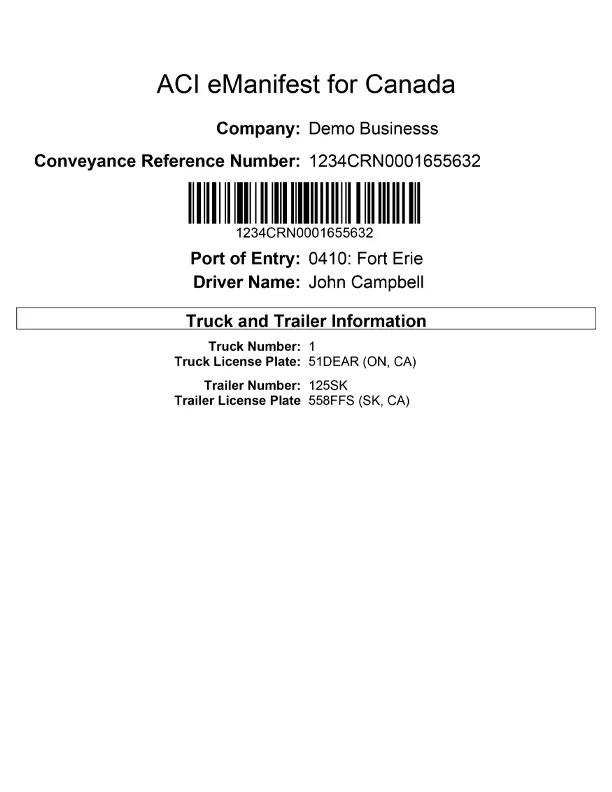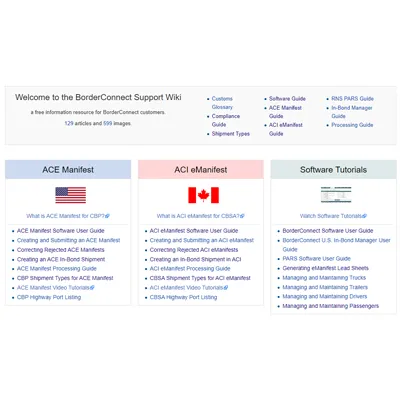ACI eManifest Requirements
Learn what's required in order to cross commercially into Canada
ACI eManifest Requirements
The Advance Commercial Information (ACI) program introduces more effective risk management processes and tools to identify threats to our health, safety, and security prior to the arrival of cargo and conveyances in Canada. The purpose of this page is to provide general information on the ACI program. For more information on ACI guidelines, you can refer to the BorderConnect ACI eManifest Software User Guide or for the CBSA eManifest Portal Guide, refer to the eManifest Portal User Guide from Canada Border Services Agency.
ACI Program Overview
The ACI program is about providing CBSA officers with electronic pre-arrival information so that they are equipped with the right information at the right time to identify health, safety and security threats related to commercial goods before the goods arrive in Canada.
ACI Requirements for Highway Carriers
Under ACI eManifest regulations highway carriers must ensure that BOTH the ACI eManifest and the entry by the customs broker (for PARS shipments) are on file with CBSA for at least one hour prior to the driver's arrival at the border. Failure to do so could result in refused entry into Canada and/or an AMPS penalty.
Any cancellation or resubmission to the ACI eManifest will start the one hour clock again.
Administrative Monetary Penalty System (AMPS)
The Canada Border Services Agency (CBSA) uses the Administrative Monetary Penalty System (AMPS) to issue monetary penalties to commercial clients for violating CBSA's trade and border legislation. The purpose of AMPS is to provide the Agency with a means to deter non-compliance by its clients and create a level playing field for all Canadian businesses.
The Master Penalty Document contains all AMPS contraventions that may be applied to commercial clients including importers, exporters, brokers, warehouse and duty free shop operators, carriers, freight forwarders or their representatives.
CBSA Monetary AMPS Penalties
| Contravention | First Penalty | Second Penalty | Third Penalty |
|---|---|---|---|
| Failure to submit ACI eManifest | $2000 | $4000 | $8000 |
| Failure to submit ACI eManifest in prescribed time or manner | $250 | $375 | $750 |
| Failure to submit correction | $500 | $750 | $1500 |
| Submission of inaccurate or incomplete information | $500 | $750 | $1500 |
| Failure to comply with CBSA notification | $1500 | $4000 | $8000 |
All penalties in CAD | source: https://www.cbsa-asfc.gc.ca/trade-commerce/amps/menu-eng.html

ACI eManifest Lead Sheet Arrival Requirements
When arriving at the border in Canada, the driver must present an ACI eManifest lead sheet to the customs officer. The lead sheet allows the officer to bring up the ACI eManifest in their system.
The lead sheet must have either:
- A barcoded Conveyance Reference Number (aka Trip Number).
- A barcoded Cargo Control Number and a handwritten Conveyance Reference Number.
- A handwritten Conveyance Reference Number on the lead sheet presented with a separate page with a barcoded Cargo Control Number (e.g. invoice with a PARS sticker).
- The officer will stamp the lead sheet only as proof of report, they will no longer stamp individual shipments. The carrier has a responsibility to keep the stamped lead sheet as proof of report.
- ACI lead sheets can be generated from within BorderConnect, either from the manifest or as a set ahead of time. The carrier can also design and produce their own lead sheets, provided that they meet the barcode requirements listed above.
ACI eManifest lead sheets can be generated from within BorderConnect, either from the manifest or as a set ahead of time. The carrier can also design and produce their own lead sheets. Learn More.
Shipment Release Types Required for ACI eManifest
The following shipment types are used for goods entering Canada via highway carrier:
- PARS (Pre-Arrival Review System) - default shipment type for commercial goods entering Canada, allows pre-clearance of goods.
- In-Bond - allows for inland movement of goods that are not considered "released" by CBSA.
- CSA (Customs Self Assessment) - special shipment type for parties enrolled in the CSA trusted trader program when all required conditions are met.
- A49 Automotive Release - special shipment type used by non-CSA carriers for shipping production automotive parts to Chrysler, Ford and GM.
- ATA Carnet - typically used for commercial samples, professional equipment and goods for use at exhibitions and fairs.
- E29B (Temporary Importation Bond) - type of temporary import.
- Goods Astray - allows for the release of goods which were previously exported from the Canada.
- Paper RMD - allows importers to obtain release of goods prior to payment of duties and taxes by presenting interim documentation, otherwise known as an RMD package.
- Paper B3 - used to account for imported goods, regardless of value, destined for commercial use in Canada.
- Personal Goods - used when non-commercial goods are transported by highway carriers.
- Orders In Council - used when goods are covered under an Order in Council granting exemption from normal release methods.
- Master Provisional - used when the importer/owner or broker cannot establish a final value for duty of goods at the time of importation.
- Automotive Line Release - special shipment type used for shipping new Ford, GM, Chrysler production vehicles to dealerships in Canada.
- Value Included - used in the event additional goods are shipped to address a shortage in a shipped order.
- Military Goods - used when goods belonging or destined to the Canadian Department of National Defence being transported by an authorized commercial carrier.
Cargo Exemptions Required for ACI eManifest
The following cargo exemptions are required to be declared for goods entering Canada via highway carrier:
- IIT (Instruments of International Trade) - used for empty racks and containers that cross the border in international transportation.
- In-Transit - used when goods are moving from point-to-point travelling through the United States.
- Flying Truck - used when freight that was originally supposed to arrive in Canada by air instead arrives by truck.
- Courier Low Value Shipment - special shipment type only available to couriers transporting low value shipments.
- Postal Shipment - used to report shipments of mail moving from a foreign postal service to Canada Post.
- Emergency Repairs - used by Canadian carriers to report emergency repairs to commercial vehicles that occur outside Canada.
- Empty ACI eManifest - Although not required at all ports, an empty conveyance can still be provided and is recommended.
Frequently Asked Questions
Below are some of the common questions customers have. If you can't find the question you're looking for please contact us and reach out to our friendly support team.










